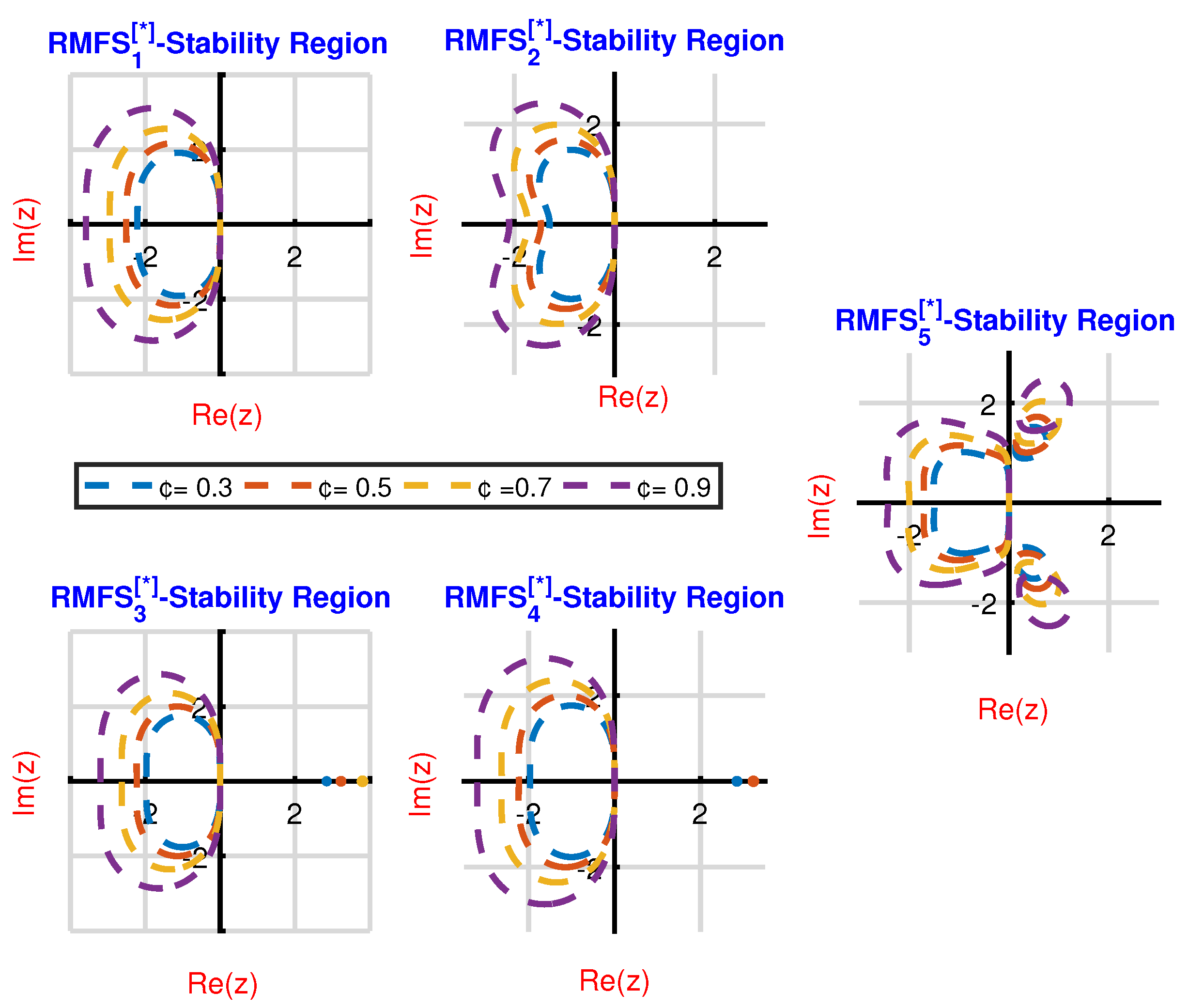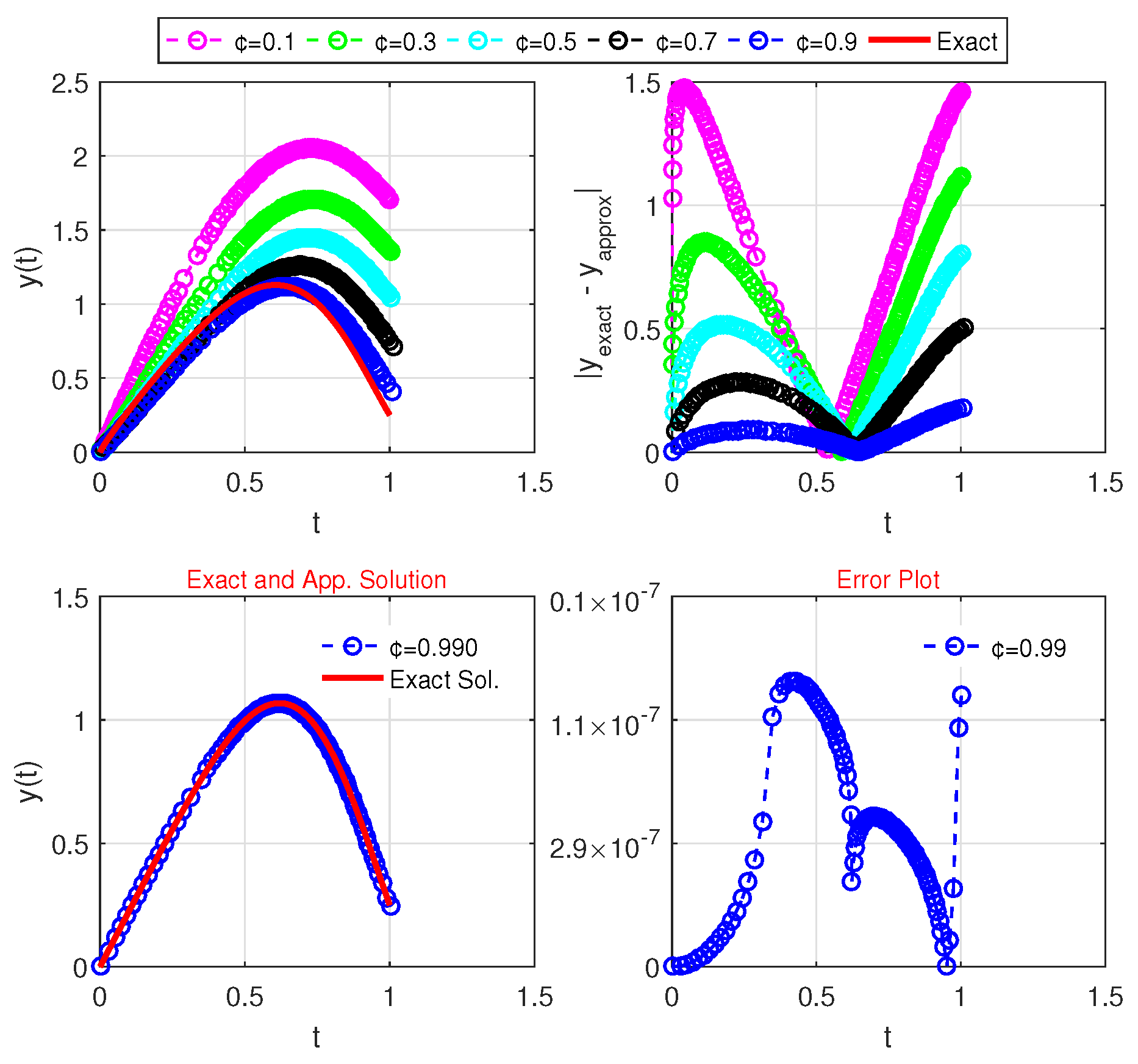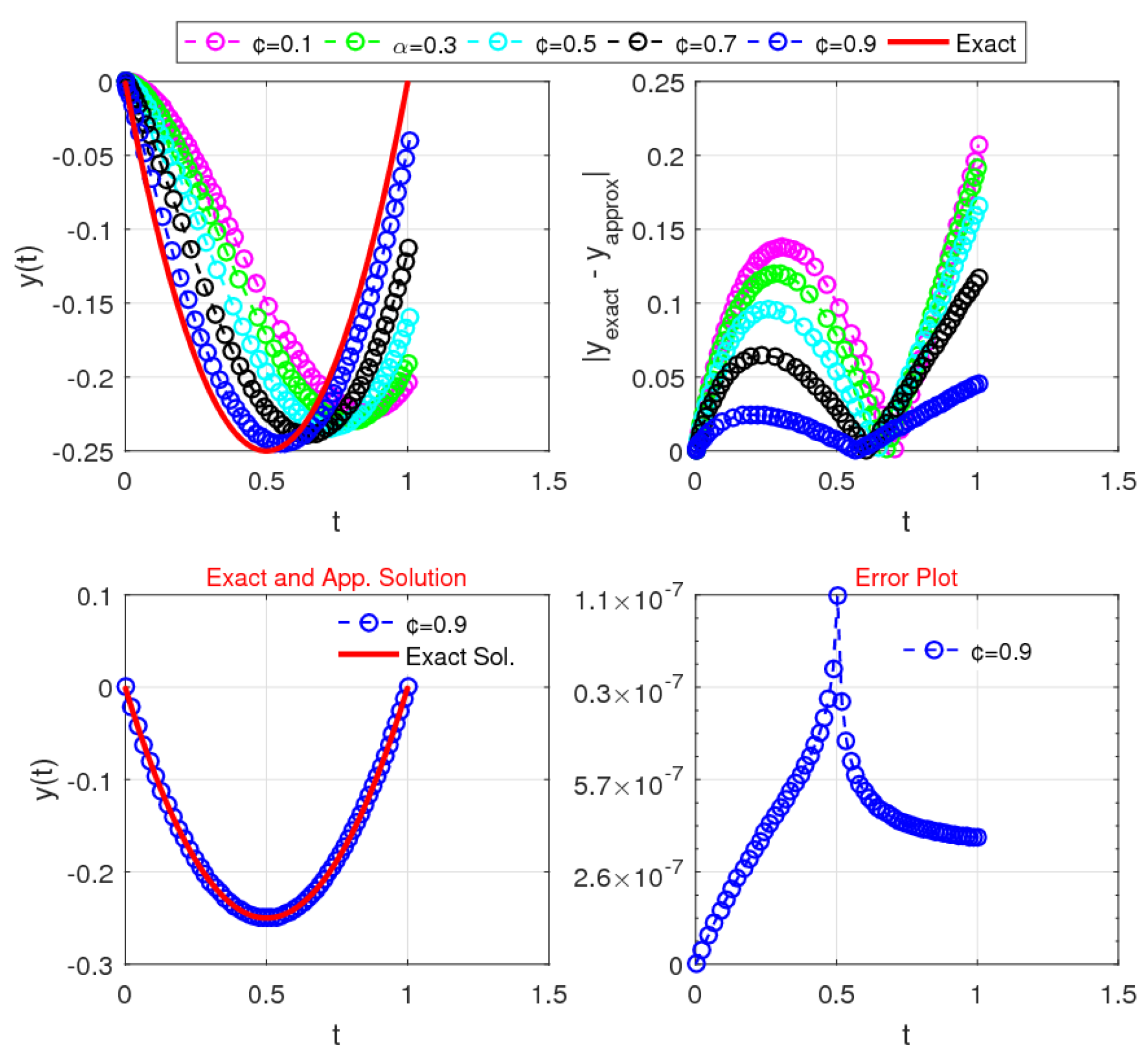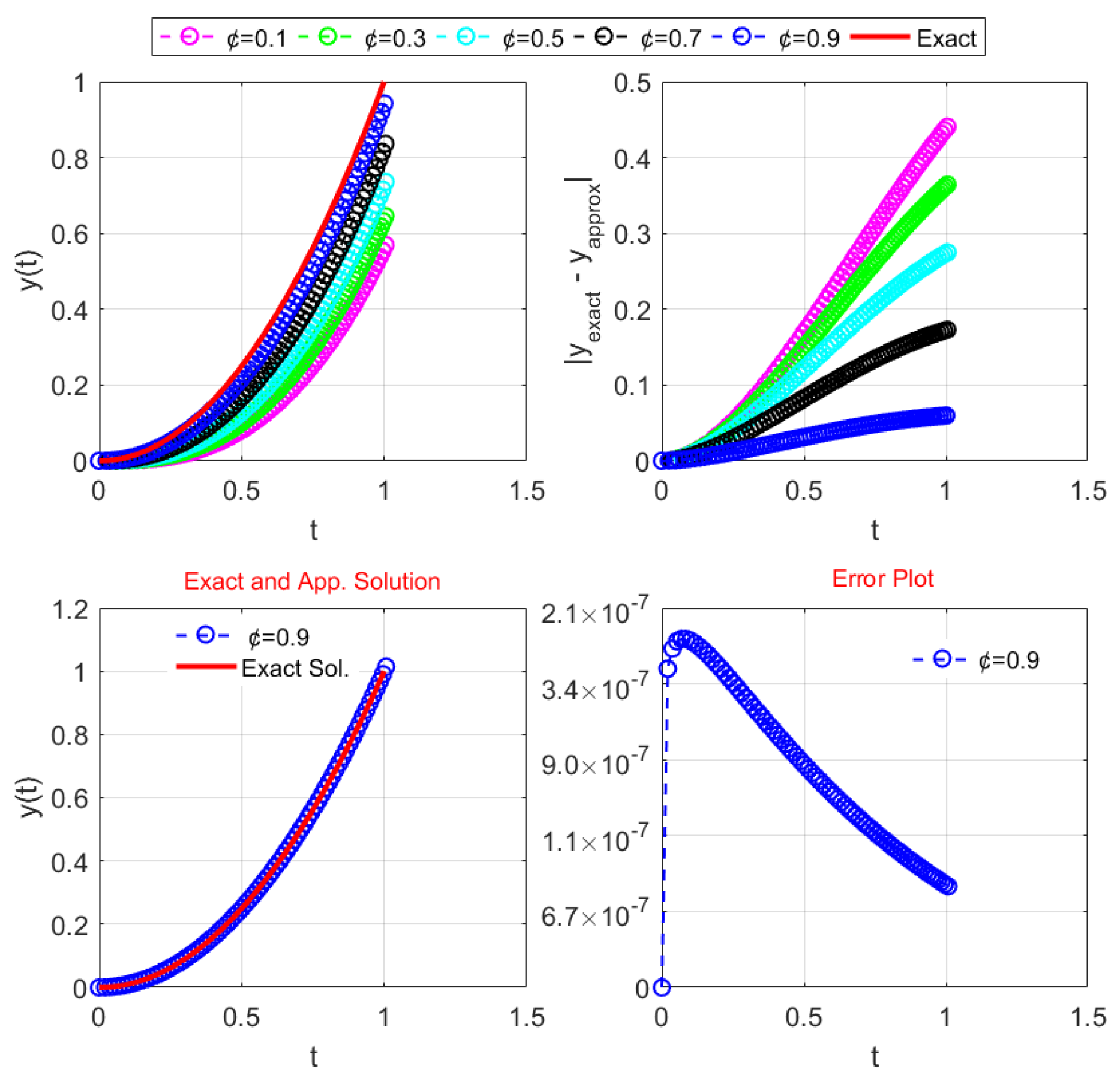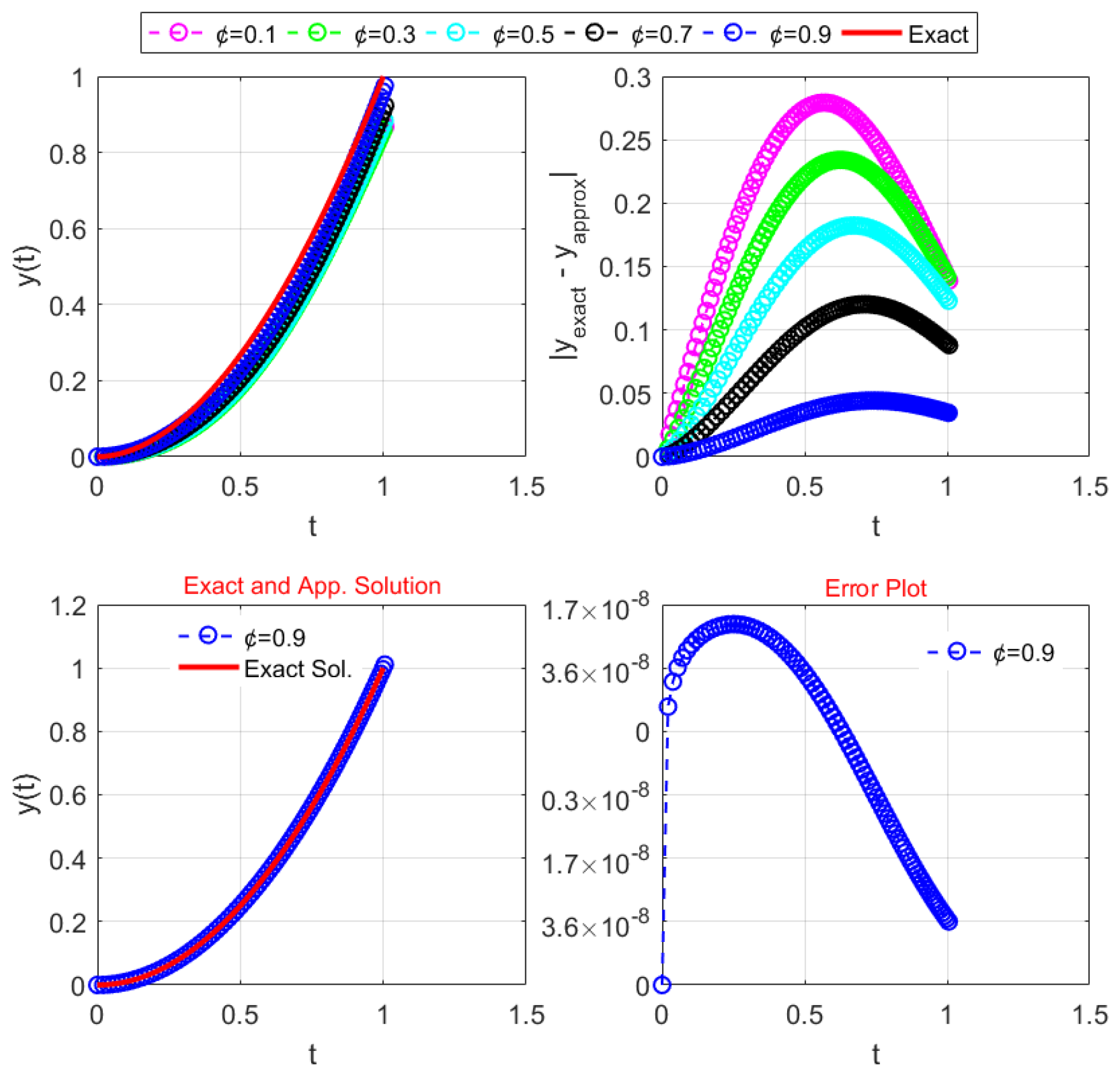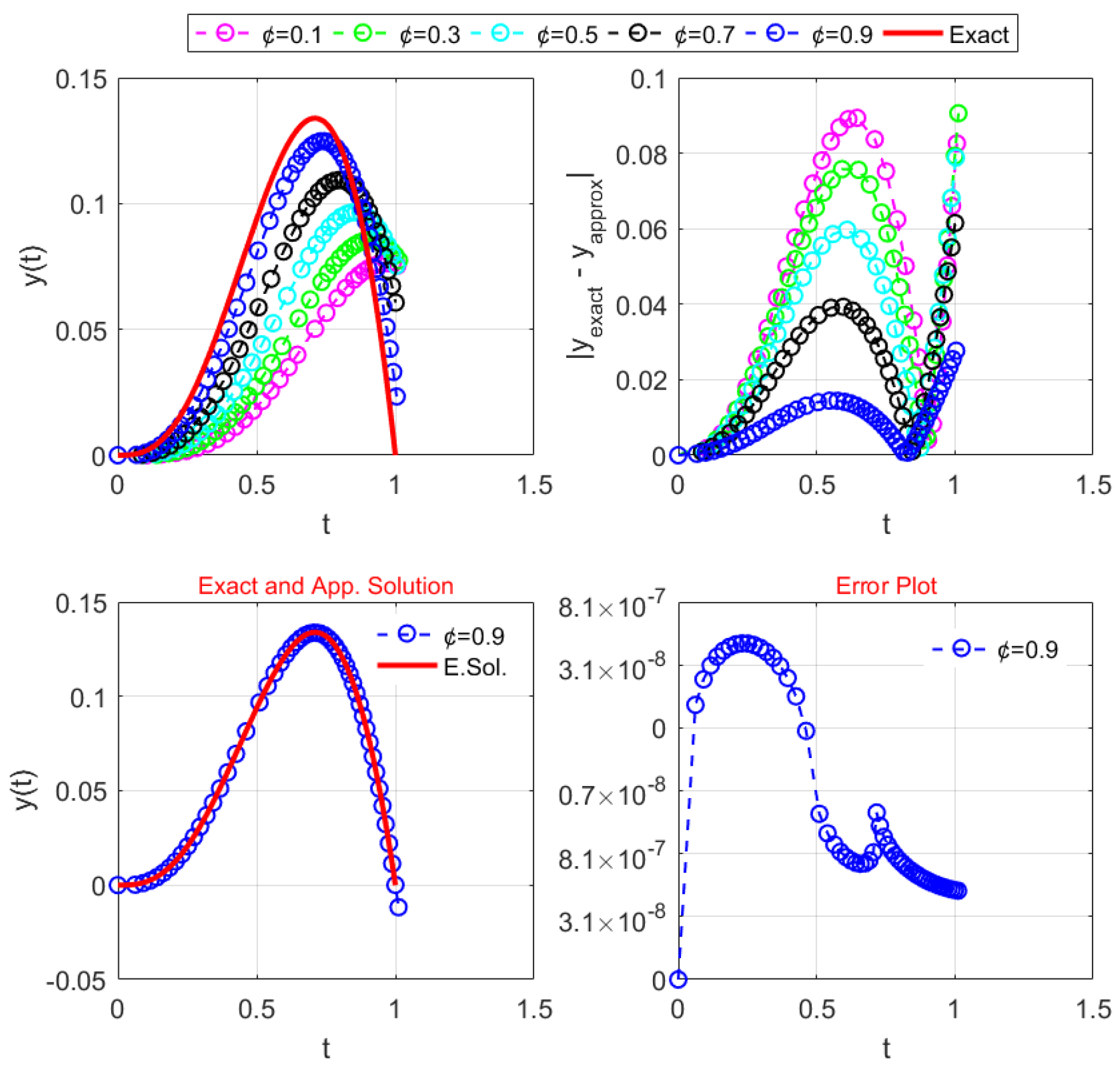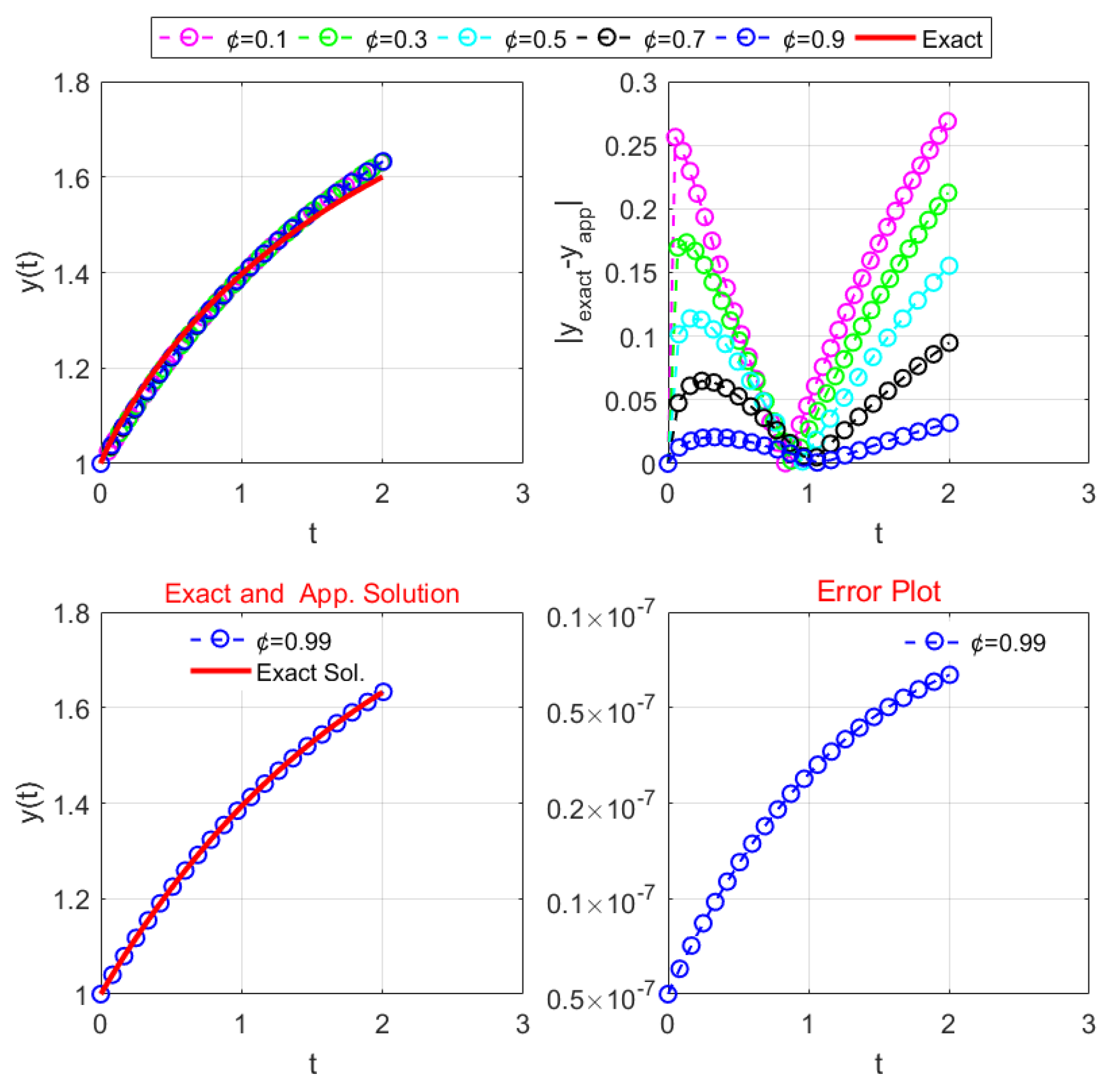To assess the accuracy and efficiency of fractional-order methods, both fixed-step-size and variable-step-size strategies are implemented in this section.
3.4. Performance Assessment
This subsection presents numerical examples to assess the efficiency, stability, and consistency of the proposed fractional-order and some existing methods. The results demonstrate the accuracy, robustness, and computational efficiency of the proposed methods.
Example 1 ([
27])
. In the first numerical example, we consider the following FIVP, which is used to effectively model complex systems with memory and hereditary features, as reported in [27]:whereThe exact solution of (60) is Table 2 illustrates the exact and approximate solutions of (
60) to five decimal places utilizing fractional schemes
with fractional parameter values of 0.5 and step length of 0.1.
Table 3 shows the error for a fixed step length of
, indicating that the newly constructed methods RMFS
are more stable than the existing methods RMFS
.
The adaptive-step-size implementation is also applied to solve Example
1, using tolerances
and
, to improve the convergence rate of fractional-order numerical schemes. The results of these numerical schemes are presented in
Table 4.
We used a variety of stopping conditions to determine the accuracy reported in
Table 4, and we utilized a common tic-toc function in MATLAB R2016a to calculate the computational time in seconds. Our developed methods, RMFS
outperform RMFS
in terms of CPU time, MSE
∞(mean square error norm), the Avg
∞ error norm, and the
error norm.
Figure 2 compares exact and approximate solutions for different fractional parameter values, along with the related error plots. This figure also shows the result for
, where the approximate solutions produced by RMFS
closely match the exact solution, indicating high precision.
Example 2 ([
28])
. Consider the fractional initial value problem as follows:where . The exact solution of (61) is Table 5 illustrates the exact and approximate solutions of Example
2 utilizing fractional schemes
with fractional parameter values of 0.5 and step length of 0.1.
Table 6 shows the error for a fixed step length of 0.1, demonstrating that the newly constructed methods RMFS
are more stable than the existing methods RMFS
.
We analyze the behavior and enhance the rate of convergence of fractional-order numerical schemes by implementing an adaptive step size using various tolerances, i.e.,
, and
.
Table 7 presents the results of the numerical schemes using adaptive step sizes.
We used a variety of stopping conditions to determine the accuracy presented in
Table 7, and we used a common tic-toc function before the loop in Matlab to calculate the computational time in seconds. In terms of CPU time, MSE
∞ (mean square error norm), the Avg
∞ error norm, and the
error norm, our recently created methods RMFS
perform better than the others schemes, i.e., RMFS
, as shown in
Table 7. This indicates better convergence behavior and a more efficient solution for fractional differential equations. In addition,
Figure 3 illustrates the associated error graph with the exact and approximate solutions for a range of fractional parameter values.
Figure 3 also clearly shows that the approximate solution exactly matches the exact solution for
using RMFS
.
Example 3 ([
29])
. Consider the fractional initial value problem as follows:where . The exact solution of (62) is Table 8 illustrates the exact and approximate solution of FIVP (
62) utilizing fractional schemes
with fractional parameter values of 0.5 and step length of 0.1.
Table 9 shows the error for a fixed step length of 0.1, demonstrating that the newly constructed methods RMFS
are more stable than the existing methods RMFS
.
We analyze the behavior and enhance the rate of convergence of fractional-order numerical schemes using an adaptive-step-size strategy.
Table 10 presents the results of the numerical schemes.
We used a variety of stopping conditions to determine the accuracy reported in
Table 10, and we used a common tic-toc function before the loop in Matlab to calculate the computational time in seconds. In terms of CPU time, MSE
∞ (mean square error norm), the Avg
∞ error norm, and the
error norm, our developed methods RMFS
perform better than the other schemes, i.e., RMFS
, as indicated in
Table 10.
Figure 4 also compares the exact and approximate solutions for various fractional parameter values, as well as the corresponding error graph.
Figure 4 also clearly shows that the approximate solution exactly matches the exact solution for
using RMFS
.
Example 4 ([
30])
. Consider the fractional initial value problem as follows:where . The exact solution of (63) is Table 11 illustrates the exact and approximate solutions of Example
4 utilizing fractional schemes
with fractional parameter values of 0.5 and step length of 0.1.
Table 12 shows the error for a fixed step length of 0.1, indicating that the newly constructed methods RMFS
are more stable than the existing methods RMFS
. We analyze the behavior and enhance the rate of convergence of fractional-order numerical schemes using the adaptive-step-size approach with various tolerances, i.e.,
, and
.
Table 13 reports the results of the numerical schemes.
We used a variety of stopping conditions to determine the accuracy presented in
Table 13, and we used a common tic-toc function before the loop in Matlab to calculate the computational time in seconds. Our recently developed methods RMFS
outperform other schemes, i.e., RMFS
, in terms of CPU time, MSE
∞ (mean square error norm), the Avg
∞ error norm, and the
error norm, as illustrated in
Table 13.
Figure 5 also compares the exact and approximate solutions for various fractional parameter values, as well as the corresponding error graph.
Figure 5 also clearly shows that the approximate solution exactly matches the exact solution for
using RMFS
.
Example 5 ([
31])
. Consider the fractional initial value problem as follows:whereand . The exact solution of (64) is Table 14 illustrates the exact and approximate solutions for Example
5 utilizing fractional schemes
with fractional parameter values of 0.5 and step length of 0.1.
Table 15 shows the error for a fixed step length of 0.1, indicating that the newly constructed methods RMFS
are more stable than the existing methods RMFS
.
Table 16 presents the results of the numerical schemes with adaptive step size.
We employed a variety of stopping conditions to determine the accuracy reported in
Table 16, and we utilized a common tic-toc function in MATLAB to compute the processing time in seconds. Our developed methods, RMFS
, outperform other schemes, including RMFS
, in terms of CPU time, MSE
∞ (mean square error norm), the Avg
∞ error norm, and the
error norm, as shown in
Table 16.
Figure 6 compares the exact and numerical solutions for different ¢ values, along with the related error plots. For
, the approximate solutions produced by RMFS
closely match the exact solution, indicating high precision of the proposed method.
Example 6 (Forced Fractional Relaxation). This model is a forced fractional relaxation system characterized by the Caputo fractional IVP [32], which is useful for describing dynamical processes in which memory and heredity effects cannot be ignored. The fractional relaxation system, which integrates prior states through the fractional derivative of order α, provides a more accurate description of complicated materials and processes compared with the classical relaxation model, which only considers the current state. This is especially relevant in viscoelasticity, dielectric relaxation, anomalous diffusion, and biomedical engineering, where experimental results frequently reveal power-law decays rather than simple exponential ones. In physiological models, the forcing term refers to an external input, such as stress, field, or metabolic stimulation. Long-term memory dynamics and non-exponential relaxation are naturally captured by the Mittag-Leffler function, a fractional counterpart of the exponential function utilized in the model’s solution. The given model can be described by the Caputo fractional initial value problemwhere the parameters are (relaxation rate), (force amplitude), (force exponent), , and The exact solution of (65) iswhere and are the one- and two-parameter Mittag–Leffler functions, defined by (see [33]) To simulate the model using fractional schemes, the following parameter values in (65) are given: is the fractional order, controlling the "memory effect" of the process.
is the relaxation rate, representing how quickly the system returns to equilibrium.
and specify constant external forcing.
is the initial state.
The termcontains two competing effects: a decay term, , which pulls the system down, and a forcing term, , which injects energy into the system. Table 17 illustrates the exact and approximate solutions for Example
6 utilizing fractional schemes
with fractional parameter values of 0.5 and step length of 0.1.
Table 17 shows the error for a fixed step length of 0.1, indicating that the newly constructed methods RMFS
are more stable than the existing methods RMFS
.
Table 18 presents the results of the numerical schemes with adaptive step size.
In
Table 19, we evaluated accuracy using several stopping conditions and computed CPU time with MATLAB’s tic-toc function. The proposed methods
−
consistently outperformed
−
in CPU time, and MSE∞, Avg∞, and
error norms, as shown in
Table 19.
Figure 7 compares the exact and numerical solutions for different ¢ values, along with the related error plots. For
, the approximate solutions produced by RMFS
closely match the exact solution, indicating high precision of the proposed method.
Physical Interpretation: This model can be interpreted as a generalized relaxation process with memory effects. In a classical relaxation system (), the solution is a simple exponential decay to equilibrium, with forcing altering the steady-state value. For , the decay is slower and follows a stretched-exponential/power-law pattern, which commonly reflects memory and hereditary features in viscoelastic materials, dielectric relaxation, or anomalous diffusion in complex media. In particular,
The term represents the natural fractional relaxation, showing how the system dissipates its initial energy.
The term represents the response to the external forcing, which gradually drives the system to a new equilibrium.
Physically, this means that the system does not forget its past in an instant; rather, it has a long memory, with prior conditions continuing to influence the present.
